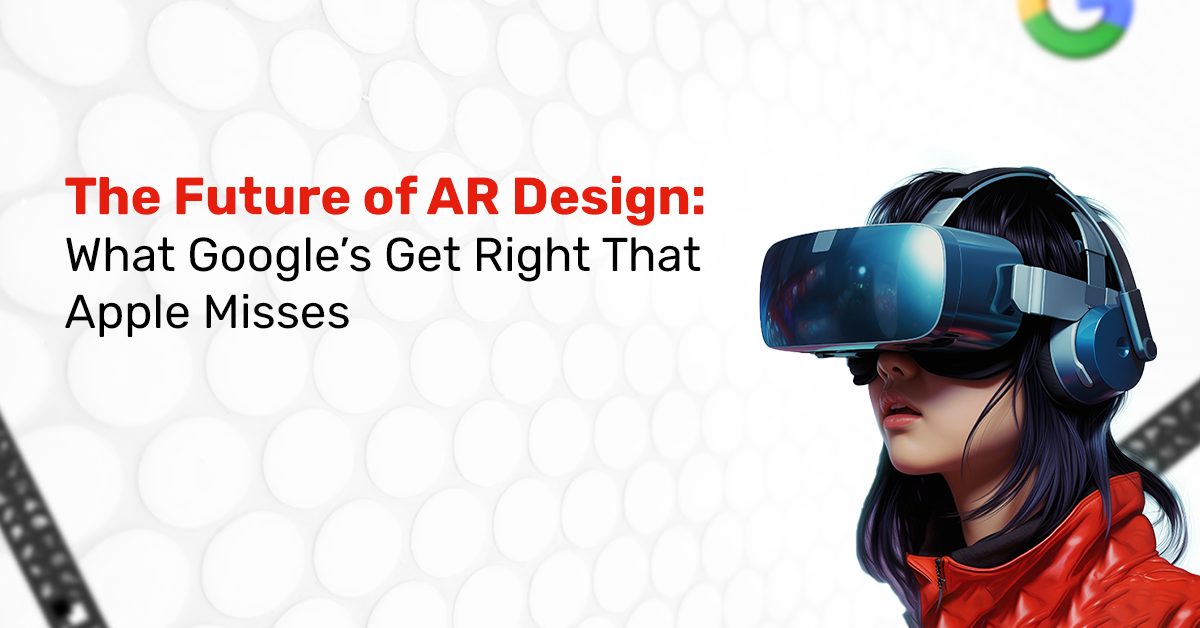The Future of Augmented reality (AR) design, which could be imagined as science fiction in the past, is now recognized as one of the most promising technologies that is changing multiple sectors.
Boosting gamers’ experiences to change how businesses affect the world, augmented reality is changing interactions with our current reality.
The increasing competition for creating the next-generation AR platforms brings into focus design.
Two giants of the tech world, Google and Apple, have adopted quite distinctive strategies for augmented reality.
So as we think about the future, it is clear that Google might have some advantage over Apple in areas where Apple seems a little weak. This is why it is time to know what Google does well when it comes to AR design and what could be improved by Apple.
Google’s AR Design Philosophy: The User-Centric Approach
Google has always been an industry leader, and the company’s take on AR is no exception. One will admire the dedicated effort by the company in developing the experiences through the ARCore platform.
Google’s principle is in the user-centered design approach, which always values usability and accessibility more than anything else.
Emphasis on Practicality
Another advantage is that Google has been concentrating on the areas where augmented reality can be used in real life.
Google is clearly focused on integrating AR technology into everyday use. Whether it’s AR directions in Google Maps or Google Lens identifying items in real-time, they’re pushing the boundaries of what’s possible. This obsession with AR is reshaping how we interact with the world around us.
In this way, by focusing on usefulness, Google guarantees that AR is not just the extra flair on top but the actual improvement of the interactions with the application.
Real-World Example: Among all types of AR applications, Google Maps AR walking directions have been quite popular.
People can point their phones forward and immediately get arrows and street names superimposed on the physical environment whenever one is lost. This feature is customer-oriented, thus solving one of the major problems related to car navigation applications.
Guidelines that Encourage Innovation
As can be seen, Google’s AR design guidelines are divided in such a way that supports innovation but still requires consistency in the design.
They offer rules that may be used by designers but, at the same time, are not rigid for creativity.
In the case of Google, context awareness is underlined that augmented reality experiences should not be static but rather adaptable to the context of use.
Data-Driven Insight: Research by PTC shows that context-based experiences have significantly higher engagement. They see a 45% boost compared to those using static AR. This highlights the power of dynamic, immersive experiences. Google’s focus on context awareness is paying off. More and more developers are showing interest in creating new applications. These applications interact with AR environments in interesting and surprising ways.
Apple’s AR Kit: Aesthetic Limitations
Apple has also been so long with a design-oriented approach that has become the company’s USP. Similarly, ARKit, which stands for Apple’s AR toolkit, has become popular as well.
In Apple’s frameworks, there is much focus on beauty, and thus such AR experiences are beautiful to look at. But this focus on design sometimes comes at the expense of usability and practicality.
Strength in Visual Design
Apple’s AR experiences undeniably look great.ARKit delivers reliable virtual objects placed in a real environment. Apple sets a tone of realism in its design principles. They guide creators to focus on rendering augmented content that feels as real as possible. Their approach emphasizes authenticity and lifelike detail in every design.
Real-World Example: Apart from the functional value, their app is located in iOS, as the standard application is a vivid example of visual design.
The app allows users to measure objects in the real world using AR. The accuracy and realism of the visual overlay are striking. However, despite its visual appeal, the app has faced criticism. It is not as intuitive or user-friendly as it could be.
Lack of Flexibility
I consider Apple’s focus on design a very strong point, but it has its downsides. Apple’s guidelines are more restricted than Google’s, which can affect creativity. Developers may find themselves constrained by Apple’s strict aesthetic standards, which can limit the scope of innovation by a long margin.
Data-Driven Insight: The Statista survey revealed that 30% of AR developers have found Apple’s guidelines very restricted rather than Google’s, and only 18% of developers share the same view.
This suggests that while Apple’s approach leads to visually stunning results, it may find some problems for the development in order to be more innovative and practical AR applications.
The Future of AR Design: Learning from Both Giants
When considering the future of AR design, you can see that Google and Apple each bring unique advantages and disadvantages to the table. A perfect kind of augmented reality in the future would be a merge of Google concepts and the purposeful Apple’s aesthetic approach.
Google’s Guideline Strengths to Focus on
User-Centered Design: In the future AR platforms, one should consider the customer experience as a key metric and those things that make the applications easy to use.
Context-Awareness: AR experiences should be furthermore immersive and proactive, where the application reacts to the current situation of the user.
Flexibility for Innovation: Specifications should provide developers with common ground while allowing flexibility for creativity. They should be detailed enough to guide the project but not so rigid that they stifle innovation in adapting to new and changing environments.
Apple Guideline Strengths to Focus on
Aesthetic Excellence: AR platforms should aim to provide the best graphics that would make the application blend with the real world.
Realism: The contrast and realism of the actual content should be a major factor of consideration since they form part of what leads to an optimally immersive experience.
Conclusion
From all of this, it’s clear that AR design is on the rise. The future development of AR design will likely depend on the strategies used by leading companies. Specifically, the approaches taken by Google and Apple have set a benchmark. Companies should consider these strategies to drive further innovation in AR design.
Google stands out by designing solutions that are helpful and useful. On the other hand, Apple is obsessed with making things look beautiful. Both approaches have their place. The direction of this industry is evolving rapidly. Companies will need to adapt to this shift. To stay ahead, they must embrace a combined concept of design. This concept should balance usability with style. For developers and designers practicing or trying to get into the AR sector, it’s crucial to think about how to use design effectively in your projects. Consider how design impacts the functionality and user experience. Aim to create solutions that are not only visually appealing but also highly functional. This approach will help you build engaging and impactful AR experiences. To develop AR experiences, it’s important to understand best practices. Consider the approaches taken by Google and Apple. By incorporating these best practices, you can create more effective and engaging AR experiences.







